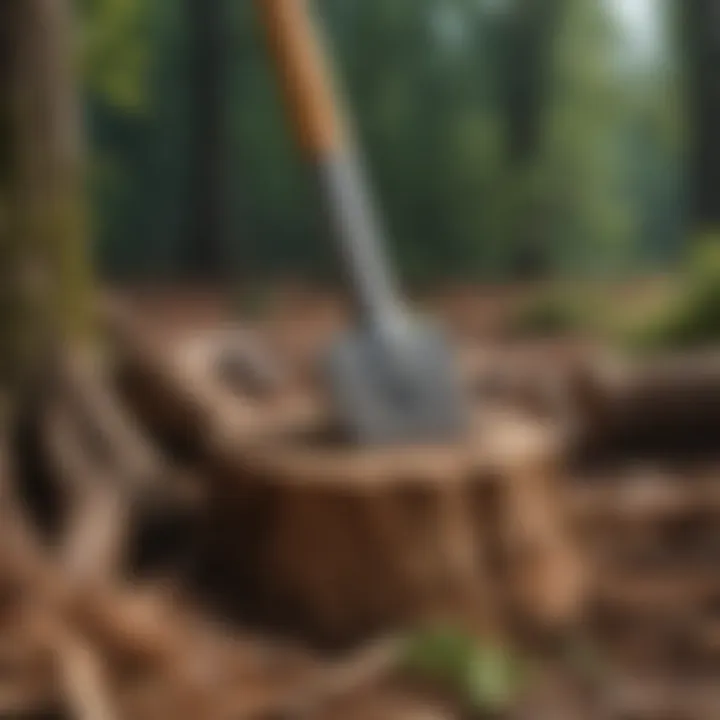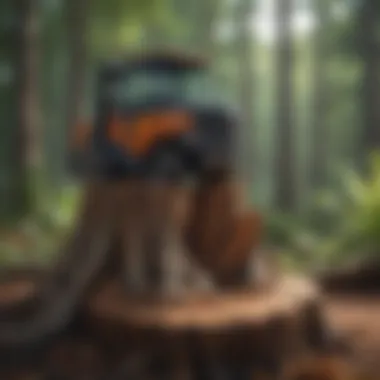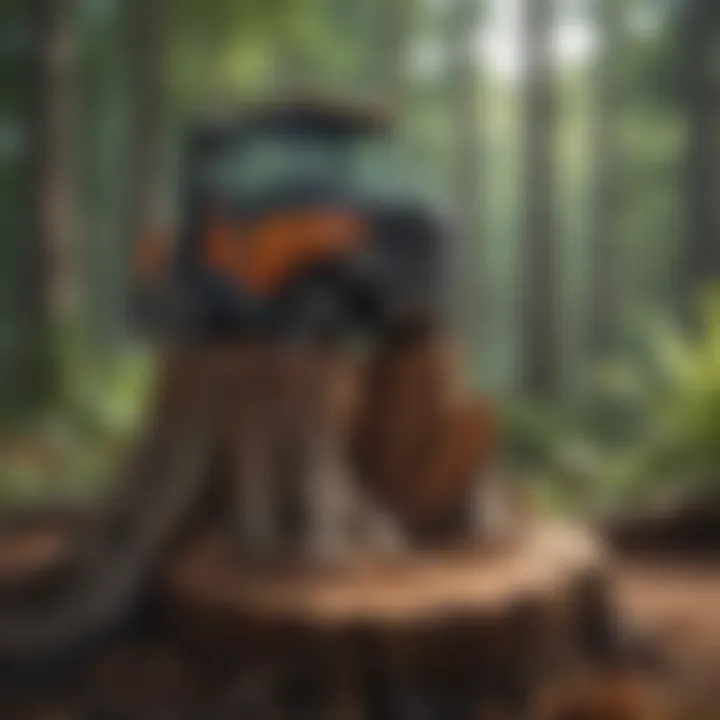A Comprehensive Guide to Removing Tree Stumps and Roots


Intro
Removing tree stumps and roots can be a challenging task for homeowners and gardening enthusiasts. Often, the remains of trees can hinder landscaping efforts and impact the aesthetic value of properties. Therefore, understanding how to effectively address this issue is essential. This guide will navigate through various methods for stump and root removal, emphasizing the tools required, important safety measures, and ecological impacts involved in this process. Knowing how to proceed can lead to better landscapes and flourishing gardens.
In this article, we will examine both manual and mechanical techniques for stump removal. Each method has its own merits depending on individual circumstances and preferences. Furthermore, attention will be given to aftercare that is necessary following the removal process. This ensures not only a clean finish but also promotes healthy soil and potential future growth in the area previously occupied by the stump.
By the end of this guide, readers should feel equipped with practical knowledge to tackle the task at hand. Understanding these aspects will ultimately save time, effort, and potentially cost in hiring professionals. Therefore, let’s delve deeper into the various methods and insights into tree stump and root removal.
Intro to Tree Stump Removal
Tree stump removal is a critical topic for homeowners and gardening enthusiasts alike. After a tree has been cut down, the leftover stump presents not just an aesthetic concern but also practical challenges. Understanding the process of removing tree stumps is essential for maintaining a safe and attractive property.
Stumps can attract pests, be a tripping hazard, and create barriers to landscaping. These issues can lead to higher maintenance costs and complications if left unaddressed. Therefore, addressing tree stump removal promptly can prevent further complications.
In many cases, removing a stump can enhance the landscape's usability. It opens up space for planting new trees, flowers, or even creating outdoor entertainment areas. This aspect contributes to improving the property's overall aesthetic value. Also, removing the stump helps eliminate the competition for nutrients and water that new plants need.
Additionally, the removal process involves careful consideration of the methods employed. Whether opting for manual techniques, mechanical equipment, or natural decomposition, each approach has its own pros and cons. Therefore, it is important to understand these aspects before commencing the removal.
In summary, tree stump removal is more than just clearing a remnant of a fallen tree. It ensures safety, enhances aesthetic appeal, and aids in successful landscaping efforts. The following sections will explore this topic in even greater depth, providing homeowners with comprehensive insights and practical tips.
Understanding the Importance of Stump and Root Removal
Removing tree stumps and roots is a significant task for many property owners. It is not just a matter of aesthetics; there are practical benefits that influence the decision to undertake this work. A visible stump can undermine the overall appeal of a landscape. However, the importance of stump removal extends beyond appearance.
Tree stumps and roots can hinder future landscaping projects. They take up valuable space, making it difficult to plant new trees or shrubs in desired locations. When planning a new garden, the presence of an old stump can force homeowners to adjust their designs or even relocate plants, which can lead to inefficiencies in the use of space.
The removal process also provides the opportunity to assess and maintain soil health. Stumps can attract pests, including termites and ants, which may invade nearby structures. Furthermore, decaying stumps act as breeding grounds for unwanted fungi that may spread to healthy plants. By removing stumps, homeowners can protect the overall health of their garden and surrounding ecosystem, ensuring a more vibrant landscape.
Important Note: Keeping stumps can lead to long-term issues that outweigh any short-term considerations, such as perceived savings.
Reasons for Removing Tree Stumps
Removing tree stumps creates a safer environment, particularly for children and pets. A protruding stump can be a tripping hazard, especially in areas where visibility is limited, such as gardens or backyards. Therefore, removing them should be seen as a safety precaution.
In addition, it is vital to consider the impact on property value. Well-maintained landscapes enhance a home’s curb appeal. Conversely, a neglected stump signals poor maintenance, which can detract potential buyers in the future. This potential impact on property value should motivate homeowners to take action with their stump removal endeavors.
- Safety improvements: Reduces risk of accidents.
- Improved aesthetics: Enhances visual appeal of the property.
- Landscaping flexibility: Allows for new plant installations without hindrance.
- Pest and disease prevention: Reduces risk of attracting destructive pests.
Potential Risks of Leaving Stumps
Leaving tree stumps in place can lead to a host of problems. One significant risk is the possibility of pest infestations. Stumps are attractive to insects, such as beetles and wood-boring termites, which are not only damaging to the stump itself but can also pose a threat to nearby trees and structures.
Moreover, stumps can result in complications during landscaping. As they decompose, they may cause uneven soil conditions. This can lead to issues with new plantings, as the soil may settle unevenly, leading to drainage problems.
In the long term, stumps can cause root competition. If left undisturbed, stumps can continue to exert influence over the surrounding soil in a way that hamstrings the health and growth of new plants. Often, the roots of the old tree may still interact with the surrounding flora, leading to stunted growth and nutrient competition.
Assessing the Site and Planning the Removal
Assessing the site and planning the removal of tree stumps and roots is a crucial part of the overall process. Proper evaluation allows you to identify the most effective method for removal based on specific site conditions and tree characteristics. This planning phase can save time, reduce risks, and ensure more successful outcomes.
Evaluating the Type of Tree and Size of Stump
Understanding the type of tree you are dealing with is essential. Different tree species have varying growth patterns and root systems. For example, hardwood trees like oak or maple typically have denser and deeper root systems than softwoods like pine and fir. This difference impacts the amount of effort and the techniques you might need to consider for removal.
Before beginning, measure the stump's diameter. A small stump might require just manual techniques, while a larger one could necessitate mechanical assistance. Originally assessing not only the physical size but also the condition of the stump helps in deciding whether to follow a manual, mechanical, or chemical removal method.
Understanding the Root System
Comprehending the root system is critical when planning stump removal. Roots can spread far beyond the stump itself, often extending two to three times the width of the crown. Mapping the root spread helps to estimate how much of the root system may still be in the ground after the stump is removed. If roots remain, they can cause complications for landscaping or future planting.


Another factor to consider is whether the roots have grown into nearby structures or utilities. This risk can pose safety hazards during the removal process. Given this, one should also review local utility maps or contact utility companies to avoid potential accidents.
Understanding the soil composition is also important. If the soil is rocky or clayey, the root removal process will be more difficult. First assess the type of soil, as it impacts how easily roots can be extracted and affects the equipment choice.
"Analysis in the initial stages can drastically improve the chances of efficient stump removal while minimizing unnecessary complications."
In summary, carefully assessing both the type of tree and understanding the underlying root system during planning leads to a more informed and effective removal strategy. By taking the time to evaluate these elements, homeowners enhance the likelihood of success and reduce the risks associated with stump removal processes.
Methods of Tree Stump Removal
Removing tree stumps effectively requires an understanding of various methods available. The choice of method can depend on factors such as the size of the stump, its root system, and the desired results. Approaching stump removal with the right technique not only enhances safety but can also save time and effort. Evaluating the specific conditions in your yard is pivotal. This makes understanding methods of stump removal an essential part of the overall process.
Manual Removal Techniques
Using Hand Tools
Using hand tools for stump removal is a straightforward and direct method. This approach means utilizing tools like axes, shovels, and pry bars. The hallmark of this method is its reliance on human strength and effort. For those who appreciate physical work, this is an appealing option. A significant advantage is that it requires minimal financial investment. However, the process can be labor-intensive and may take considerable time depending on the stump's size.
An important characteristic of hand tools is their versatility. By employing different tools, one can effectively address various stump conditions. Consideration must be given to the physical effort involved, as it may not be suited for everyone.
Leveraging Mechanical Advantage
Leveraging mechanical advantage involves using tools like pulleys, winches, or lever systems. This method helps multiply physical effort, making it easier to uproot larger stumps. The key characteristic of this approach is its efficiency. It allows individuals to exert less force while achieving significant results. This makes it a popular choice for more challenging stumps.
A unique feature of using mechanical advantage is how it reduces the risk of injury. By applying force in a controlled manner, individuals can work safely. However, one downside is the potential need for specialized equipment, which may require a rental fee.
Mechanical Removal Techniques
Stump Grinder
The stump grinder is a powerful machine designed to grind down tree stumps into mulch. The main contribution of this device is its speed and effectiveness in removing stumps thoroughly. The key characteristic that stands out is its ability to handle substantial stumps quickly. It is often a beneficial choice for those who have multiple or large stumps to eliminate. The grinder's rotating blades can chew through wood with ease, making it a preferred method for many.
One unique feature of the stump grinder is its range of adjustment, allowing operators to control the depth of grinding. This means the grinder can be used in various types of terrain. However, one disadvantage is that it requires some operating knowledge and safety precautions, as improper use can lead to accidents.
Excavation Equipment
Using excavation equipment, such as backhoes or mini excavators, offers a robust solution for stump removal. This method is particularly useful for large stumps with extensive root systems. The characteristic benefit is that it allows for a complete removal of the stump and the surrounding roots. This form of removal may also expedite the process significantly.
A unique aspect of excavation equipment is its capacity to handle tough soil conditions. This versatility makes it suitable for different landscapes. The downside, however, includes higher costs associated with renting or hiring heavy machinery. Additionally, there may be a risk of soil disturbance during removal.
Chemical Stump Removal
Types of Chemicals
Chemical stump removal methods generally involve the use of herbicides or potassium nitrate. These substances accelerate decomposition processes, contributing to the eventual breakdown of the stump. The main advantage is a lesser physical effort compared to manual methods. The ease of application allows for convenience when it comes to larger stumps.
A common characteristic is that chemicals can be applied without the immediate need for heavy machinery. However, caution is necessary when using chemicals, as they may affect surrounding vegetation and soil health if misapplied.
Application Methods
Application methods for chemicals vary significantly. They can include drilling holes into the stump and applying concentrated chemicals. This method allows for deeper penetration, improving results. Another consideration includes wetting the stump prior to treatment to enhance absorption.
The key aspect of using chemical methods lies in their low physical labor requirement. Yet, one must also consider the time it takes for chemicals to break down the wood. This process might take weeks or even months, meaning this method is not suitable for immediate removal needs.
Natural Decomposition Methods
Using Nitrogen-Rich Fertilizers
Using nitrogen-rich fertilizers fosters faster decay of tree stumps. By applying fertilizer, you promote microbial activity that speeds decomposition. This method aligns with environmentally-friendly practices, appealing to those who prioritize sustainability in gardening efforts. The primary advantage is the minimal effort required once the fertilizer is applied.
A notable characteristic is that this method can be viewed as a long-term solution. It encourages soil health improvement even after the stump is gone, benefiting future plant growth. However, it may require significant time before noticeable results occur.


Encouraging Fungi Growth
Encouraging fungi growth around stumps is another natural approach. Fungi break down wood fibers and decompose them over time. This method is effective and environmentally sound. A key benefit to encouraging fungi is the low investment needed, aside from some basic moisture management.
The unique feature is that this process can enhance biodiversity in the soil. Increased fungi can also improve overall soil health. Yet, as with other natural methods, this process requires patience. Results may not be immediate, and time must be allowed for fungi to establish and flourish.
Safety Precautions During Removal
When embarking on the task of removing tree stumps and roots, safety precautions are critical. The process often involves heavy machinery and sharp tools, making it essential to prioritize your safety and the safety of those around you. Proper precautions can significantly reduce the risk of accidents, injuries, and lead to a more successful removal experience.
Personal Protective Equipment
Wearing appropriate Personal Protective Equipment (PPE) is an indispensable part of any stump removal project. Here are some key items to consider:
- Safety Goggles: Protects your eyes from flying debris.
- Gloves: Offers grip and shields hands from sharp edges.
- Steel-Toed Boots: Avoids injuries from heavy equipment.
- Hard Hat: Essential in case of falling branches or debris.
- Ear Protection: Reduces the risk of hearing damage from loud machinery.
Using the right PPE not only protects you but also increases your confidence while working. It creates a safeguard against the potential hazards associated with stump removal, allowing you to focus more on the task at hand.
Identifying Hazardous Conditions
Identifying hazardous conditions is crucial before beginning the removal process. Here are some factors to watch for:
- Weak Ground Stability: Soft mud or loose soil may increase the risk of slipping or falling.
- Nearby Power Lines: Overhead lines can pose serious threats, particularly when using large machinery.
- Other Structures: Be aware of buildings, fences, or other items nearby that could get damaged.
- Weather Conditions: Rain or high winds can make outdoor work dangerous and should be avoided.
By recognizing these hazards in advance, proper planning can help mitigate risks. Before starting work, scan the area and address any potential dangers. Ensuring a safe work environment is the first step toward successful stump removal.
Post-Removal Considerations
After successfully removing a tree stump and its roots, the next phase involves several important considerations to ensure the area is left in good condition and effectively utilized. Many homeowners may overlook this step, thinking removal is sufficient. However, careful attention to post-removal activities can have significant benefits for your landscape and soil health.
Filling the Hole
Once the stump is out, you will likely face a sizeable cavity. Filling this hole properly is crucial. Leaving it empty can lead to erosion, water pooling, or even pest problems. You can use a variety of materials to fill the hole, including soil, compost, or a combination of both.
- Choose the Right Materials:
- Layering Technique: To avoid future settling, fill the hole in layers, compacting each one slightly before adding more material. This can prevent sinkholes or uneven surfaces in your yard later on.
- Avoiding Invasive Species: When replacing soil, ensure it is free from weeds or invasive plants that could compete with your desired landscaping.
- Topsoil is often preferred as it integrates well with existing soil and provides a base for future planting.
- Compost adds nutrients to the soil and improves its structure, which is beneficial for growth.
Landscaping and Restoration
The final aesthetic and functional outcome of your yard post-stump removal largely depends on strategic landscaping and restoration. This phase allows you to redefine your landscape layout and foster new growth.
- Planning New Plantings: Think about incorporating new plants in the area where the stump used to be. This could enhance the visual appeal of your garden while ensuring that the ground is put to good use.
- Soil Nutrition: After filling the hole, it might be beneficial to improve the surrounding soil by incorporating fertilizers or organic matter. This can enhance soil fertility, supporting new plant growth.
- Maintaining Erosion Control: If the filled area is on a slope, ensure that your landscaping choices prevent further erosion.
- Mulching: A layer of mulch can help retain moisture and suppress weeds in the newly planted area, contributing to overall landscape health.
- Consider Native Plants: They are often hardier and require less maintenance.
- Flowering Plants: These can attract pollinators and add vibrant colors.
To ensure a thriving environment post-removal, plan your restoration carefully and focus on creating an ecosystem that benefits from the changes.
Environmental Considerations
Tree stump and root removal is not merely a challenge for homeowners. It poses several environmental considerations that merit attention. Understanding how your actions can affect soil health and local ecosystems is vital. This section explores the key aspects related to the environment and emphasizes the broader implications of stump removal.
Impact on Soil Health
When tree stumps and roots are removed, it significantly impacts the surrounding soil. Leaving a stump can lead to various problems, such as soil erosion and loss of nutrients. The decay process of a stump returns organic material back into the soil. However, over time, the area may become compacted and less productive. Therefore, removing stumps allows for better soil aeration and promotes healthier growth for surrounding plants.
- Soil Structure: The removal can improve soil structure. It enhances the movement of air, water, and nutrients, preventing stagnation.
- Nutrient Availability: Clearing stumps makes space for other vegetation. As a result, new plants can take advantage of the nutrients that would have been consumed by the decaying stump.
- Microbial Activity: The process of stump decay fosters certain types of microbial life. When you remove stumps, ensure to introduce other organic matter to maintain microbial activity, which is essential for soil health.
"Proper stump removal can rejuvenate soil health, making it more suitable for future plant growth."
Ecosystem Effects


Removal of tree stumps may have noticeable effects on local ecosystems. Trees play crucial roles in a habitat. Therefore, any change can disrupt the delicate balance.
- Habitat Disruption: Stumps provide habitats for various insects and small creatures. Removing them can contribute to loss of biodiversity in your garden or forested area.
- Food Source: Many wildlife species rely on decaying wood for food. The absence of stumps can reduce food sources, impacting local wildlife populations.
- Water Retention: Tree roots help with water retention in the soil. Removal may alter the moisture level, affecting other plants' ability to thrive.
Hiring Professionals vs. DIY
When it comes to removing tree stumps, homeowners often face a decision: should they hire professionals or attempt the task themselves? Each choice comes with its own advantages and drawbacks. Understanding these elements can significantly influence the success of the removal process.
Hiring professionals can offer a suite of benefits. Firstly, they possess the experience and expertise that many homeowners may lack. Specialized knowledge in the correct techniques and necessary equipment can lead to a more efficient and effective removal. Furthermore, professionals are usually equipped with powerful machinery, such as stump grinders, that can do the job quickly and safely. This can be particularly important for larger or deeper stumps which require precision.
On the other hand, a DIY approach has its own appeal. For budget-conscious homeowners, doing the job themselves can be significantly less expensive. There is also a sense of satisfaction in completing a home improvement project independently. However, one must consider the time involved, as some methods can be very labor-intensive. It is crucial to evaluate whether the investment in time aligns with personal schedules and energy levels.
When to Hire Professionals
Several factors should guide homeowners in deciding when to hire professionals for stump removal. The size and type of tree are key considerations. For example, large tree stumps often have extensive root systems that can complicate removal. If a stump is larger than 18 inches in diameter, professional help may be warranted.
Additionally, if the stump is located near essential structures like fences, pathways, or underground utilities, a professional’s knowledge can help prevent damage. Situations involving hazardous materials, such as the presence of pests or diseases, also require expert attention for safety reasons. If unsure about the depth of roots or the potential soil disturbance, consulting professionals may be necessary.
Cost Considerations
Cost is a significant factor when choosing between DIY and hiring professionals. The expense of professional services is often reflective of the complexity of the job. Homeowners might pay anywhere from $100 to $1,500 depending on the stump's size, location, and removal method.
Investing in professional removal can lead to long-term benefits, like preventing future issues with root growth that can affect landscaping. In contrast, DIY removal might require only minor tool expenses and any personal labor costs. This can range from a few dollars for hand tools to the rental of larger machinery.
Ultimately, assessing both initial costs and potential long-term consequences of each choice will help in making a sound decision.
Tools and Equipment for Stump Removal
Removing tree stumps and roots effectively requires proper tools and equipment. These tools not only make the task easier but also enhance safety and efficiency. Knowing what tools are essential can save time and effort, ensuring a successful removal process.
First, let's discuss why selecting the right tools is so crucial. Appropriate tools can reduce physical strain, minimize risks of injury, and expedite the task. Each tool serves a specific purpose, and understanding these purposes makes it easier to choose what is best suited for the job.
Essential Hand Tools
Hand tools are often the first line of defense in stump removal. They provide the user with control and precision, especially in smaller spaces or when dealing with intricate root systems. Some essential hand tools include:
- Shovel: Helpful for digging around the stump and loosening soil. A sharp spade shovel can penetrate compacted earth more easily.
- Mattock: This tool combines a pickaxe and a hoe. It is effective for loosening soil and digging down to roots.
- Pruning Saw: Ideal for cutting through roots. A handsaw can be maneuvered in tight places.
- Crowbar: Useful for levering large roots out of the ground. It provides the necessary leverage to loosen stubborn roots.
- Hatchet: Effective for chopping through small roots. It offers better precision than a larger axe.
Using these hand tools requires a certain level of physical effort and endurance. However, they are practical for homeowners, as they do not require special training or heavy machinery. Having these tools readily available will facilitate the stump removal task significantly.
Equipment for Mechanical Removal
For larger stumps or those in difficult locations, mechanical removal equipment becomes necessary. Mechanized tools can deal with larger jobs faster and often with less physical labor. The common pieces of equipment for mechanical removal include:
- Stump Grinder: This is a powerful machine designed specifically for grinding down tree stumps. It uses a rotating blade to chip away at the stump, usually down to below ground level. Using a stump grinder is effective but requires some operator training to ensure safe operation.
- Excavation Equipment: This includes backhoes or mini-excavators, which can help pull or dig out stumps and roots. These machines are especially useful for dealing with large or deep-rooted trees.
- Chainsaw: While primarily used for cutting the trunk down, it also assists in removing parts of the stump. Combining it with other equipment can promote more efficient removal.
The investment in mechanical tools may vary based on the scope of the job and the available budget. For homeowners considering their options, renting rather than purchasing equipment can be a cost-effective choice.
Using the right tools and equipment for stump removal can make all the difference in efficiency and safety. Ensuring you have the necessary tools at hand will prepare you for whatever challenges arise during the process.
Selecting the right tools and understanding their functions is essential for tree stump removal. Armed with the correct hand tools or equipment, homeowners can tackle stump removal projects more effectively.
End
The conclusion of an exhaustive guide on removing tree stumps and roots serves several critical roles. It encapsulates the essential information outlined earlier in the article while reinforcing the significance of proper stump removal in gardening and landscaping.
Through various methods discussed, from manual techniques to chemical approaches, homeowners are equipped to choose the most suitable options. Understanding these methods allows for informed decisions, which can lead to optimal results in stump removal.
A key element in this topic is the aftercare process. Properly addressing the site post-removal can enhance the landscape's aesthetic appeal and promote healthier growth for surrounding plants. This consideration ensures that any environmental impacts from the removal process are minimized and that soil nutrition is maintained.
Additionally, the article emphasizes safety as an essential component. Following the outlined safety precautions protects not only the individual undertaking the task but also those around them. A careful approach can mitigate risks associated with the equipment and materials used in the removal process.
In summary, the conclusion underlines the following benefits and considerations:
- Knowledge Application: Readers are empowered with knowledge to make informed choices regarding their stump removal strategies.
- Environmental Health: Emphasizing post-removal care aids in sustaining soil and ecosystem balance.
- Safety First: A reiteration of the importance of safety measures can prevent accidents from occurring.
Ultimately, the effective removal of tree stumps and roots contributes to the overall health and appearance of residential spaces, fulfilling both practical and aesthetic goals for homeowners. Incorporating the insights from this article will lead to successful stump removal and a more enjoyable gardening experience.



